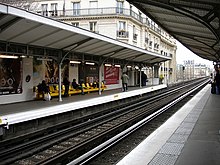Passy (Paris Metro)
|
|
|
|---|---|

|
|
| Tariff zone | 1 |
| Line (s) |
|
| place | Paris XVI |
| opening | 5th November 1903 |
The metro station Passy is a largely aboveground station line 6 of the Paris Métro .
location
The station is located on the southeastern edge of the Quartier de la Muette in the 16th arrondissement of Paris . It is located below and above the Rue de l'Alboni northwest of the Avenue du Président Kennedy.
Surname
The 16th arrondissement is also called the Arrondissement Passy . Passy was a village first mentioned in 1250, which was incorporated into Paris in 1860.
history
The station was put into operation on November 5, 1903 as the provisional new end point of the then line 2 Sud coming from Trocadéro . Initially, the station was only shortened, its final length was obtained with the continuation of the line to Place d'Italie on April 24, 1906. In October 1907, the previously independent line 2 Sud was given up and moved to the south-western end of line 5 ( Étoile - Gare du Nord ). On October 6, 1942, the route was changed again, so that line 6 has been running at the station since then.
description
The 75 m long station is located on the northern slope of the Seine over the southern section of the Rue de l'Alboni. This street was divided in two by the construction of the Métro. The railway runs under its northern section in a tunnel position . About halfway along the Rue de l'Alboni has a steep incline and only exists there in the form of two stairs on either side of the metro station. The line emerges from the embankment there, the southeastern part of the station crosses Square Alboni street on a viaduct . The side platforms on the two main tracks begin in the tunnel. They are roofed over their entire length outside the tunnel, their side walls are bricked and loosened up towards the outside with geometric patterns. The two entrances to the station are about halfway up the stairs.
Subsequently to the southeast, the line crosses the Seine as an elevated railway on the Pont de Bir-Hakeim bridge (before 1949: Pont de Passy) built between 1903 and 1906 .
vehicles
Initially, four-car trains consisting of two short, two-axle sidecars and corresponding railcars at the two ends of the train ran on the then line 2 Sud. Only after the station was expanded and the line continued to Place d'Italie could longer trains be used. From around 1910 trains of the Sprague-Thomson type ran on the route . In July 1974, line 6 was switched to rubber-tyred vehicles, and the MP 73 series has been operating there ever since .
Others
In the immediate vicinity of the Passy station, in the building 1 Rue de l'Alboni (in the film: Rue Jules Verne), the main plot of the film The Last Tango in Paris takes place .
gallery
On the platform in the direction of Étoile, an MP 73 train , 1994
Web links
literature
- Gérard Roland: Stations de métro. D'Abbesses à Wagram . 2003, ISBN 2-86253-307-6 .
Individual evidence
- ^ Gérard Roland: Stations de métro d'Abbesses à Wagram . Christine Bonneton, Clermont-Ferrand 2011, ISBN 978-2-86253-382-7 , pp. 157 f .
- ^ Jean Tricoire: Un siècle de métro en 14 lignes. De Bienvenüe à Météor . 2nd Edition. La Vie du Rail, Paris 2000, ISBN 2-902808-87-9 , p. 210 .
- ↑ Jean Tricoire: op. Cit. P. 207.
- ^ Brian Hardy: Paris Metro Handbook . 3. Edition. Capital Transport Publishing, Harrow Weald 1999, ISBN 1-85414-212-7 , pp. 36 .
- ↑ Jean Tricoire: op. Cit. P. 209.
| Previous station | Paris metro | Next station |
|---|---|---|
|
Trocadéro ← Charles de Gaulle - Étoile |
|
Bir-Hakeim Nation → |
Coordinates: 48 ° 51 ′ 27 ″ N , 2 ° 17 ′ 9 ″ E






